
The Royal Horticultural Society (RHS), founded in 1804 as the Horticultural Society of London, is the UK's leading gardening charity.

Sparaxis is a genus of flowering plants called the harlequin flowers. It belongs to the iris family Iridaceae with about 13 species endemic to Cape Province, South Africa.

Freesia is a genus of herbaceous perennial flowering plants in the family Iridaceae, first described as a genus in 1866 by Christian Friedrich Ecklon (1886) and named after the German botanist and medical practitioner, Friedrich Freese (1795-1876). It is native to the eastern side of southern Africa, from Kenya south to South Africa, most species being found in Cape Provinces. Species of the former genus Anomatheca are now included in Freesia. The plants commonly known as "freesias", with fragrant funnel-shaped flowers, are cultivated hybrids of a number of Freesia species. Some other species are also grown as ornamental plants.

Gladiolus is a genus of perennial cormous flowering plants in the iris family (Iridaceae).

Crocosmia (;), also known as montbretia, is a small genus of flowering plants in the iris family, Iridaceae. It is native to the grasslands of southern and eastern Africa, ranging from South Africa to Sudan. One species is endemic to Madagascar.

Agapanthus inapertus, the Drakensberg agapanthus, drooping agapanthus, or closed African lily, is a species of flowering plant in the family Amaryllidaceae, native to open grasslands, forest margins and mountainous, rocky areas of Mozambique, Eswatini (Swaziland), and South Africa.
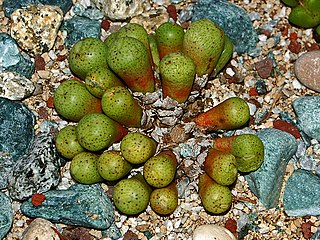
Conophytum jucundum is a species of succulent plants belonging to the family Aizoaceae. As its synonym Conophytum gratum, the pleasing cone plant, it has gained the Royal Horticultural Society's Award of Garden Merit.

Pleiospilos bolusii, the mimicry plant, is a species of flowering plant in the family Aizoaceae, native to the Eastern Cape of South Africa, where it grows at an altitude of 750–1,100 m (2,461–3,609 ft). The species epithet bolusii honours Harry Bolus, a 19th-century South African botanist.

Nerine masoniorum is a species of flowering plant in the family Amaryllidaceae, subfamily Amaryllidoideae, native to the eastern Cape Province of South Africa. It is a bulbous perennial belonging to the group of nerines that have narrow evergreen foliage. The thread-like leaves reach a length of 25 cm or more. The flowering stem is 15–25 cm tall, with up to 11 flowers arranged in an umbel. Each flower has six narrow pink tepals with wavy edges. It flowers in late summer in cultivation, the first of the nerines to do so. It has received the Royal Horticultural Society's Award of Garden Merit.
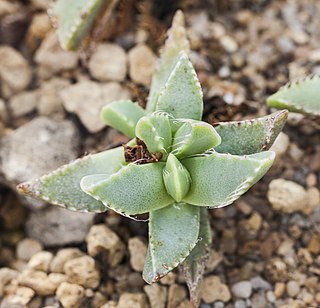
Faucaria felina, tiger jaws, is a species of succulent plant in the family Aizoaceae. It is endemic to the southern Cape Provinces of South Africa, but also widely spread in culture. It has a clumping habit and blooms with yellow flowers. As its synonym Faucaria candida, white tiger jaws, it has gained the Royal Horticultural Society's Award of Garden Merit.

Protea caespitosa, also known as hottentot bishop sugarbush or bishop sugarbush, is a flowering shrub belonging to the genus Protea which is only found growing in the wild in South Africa.

Neohenricia is a genus of flowering plants in the family Aizoaceae, native to South Africa. Low-lying succulents, they are found in places that can collect a little water, such as crevices and pans, on sandstone or dolorite, in areas that get at least 200 mm of rainfall annually.
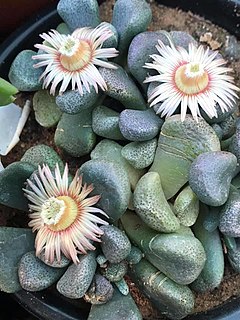
Aloinopsis schooneesii is a species of flowering plant in the genus Aloinopsis, in the ice plant family Aizoaceae, native to the eastern Cape Provinces of South Africa. It has gained the Royal Horticultural Society's Award of Garden Merit.
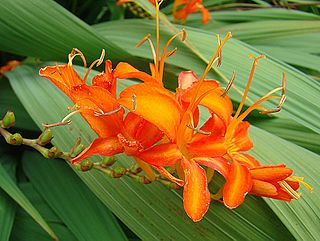
Crocosmia masoniorum, called the giant montbretia, is a species of flowering plant in the genus Crocosmia, native to South Africa. It has gained the Royal Horticultural Society's Award of Garden Merit.
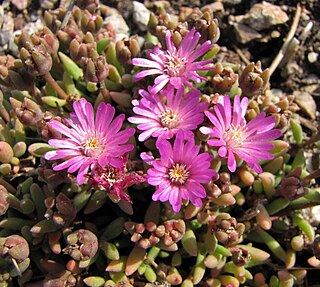
Delosperma aberdeenense, called the Aberdeen dew plant, is a species of flowering plant in the ice plant family Aizoaceae, native to the Cape Provinces of South Africa. It has gained the Royal Horticultural Society's Award of Garden Merit.

Pleiospilos compactus, called living rock, is a species of flowering plant in the ice plant genus Pleiospilos, native to the southwestern Cape Provinces of South Africa. A succulent, it has gained the Royal Horticultural Society's Award of Garden Merit.
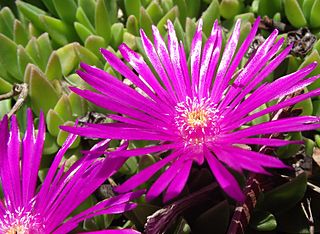
Delosperma lavisiae is a species of flowering plant in the family Aizoaceae, native to South Africa and Lesotho. It goes by a number of common names relating to its habitat, growing as high as 2,650 m (8,700 ft) up in the Drakensberg mountains; Drakensberg ice plant, Drakensberg vygie, and mountain vygie. A mat‑forming, cold hardy succulent, able to withstand occasional frosts as low as −20 to −15 °C, it has gained the Royal Horticultural Society's Award of Garden Merit.
Plectranthus ambiguus, the pincushion spurflower, is a species of flowering plant in the family Lamiaceae, native to South Africa. Its cultivar 'Manguzuku' has gained the Royal Horticultural Society's Award of Garden Merit.
Stomatium alboroseum is a species of succulent plant in the family Aizoaceae, native to the Cape Provinces of South Africa. Under its synonym Stomatium niveum it has gained the Royal Horticultural Society's Award of Garden Merit.

















